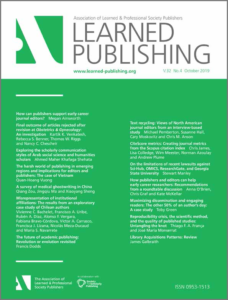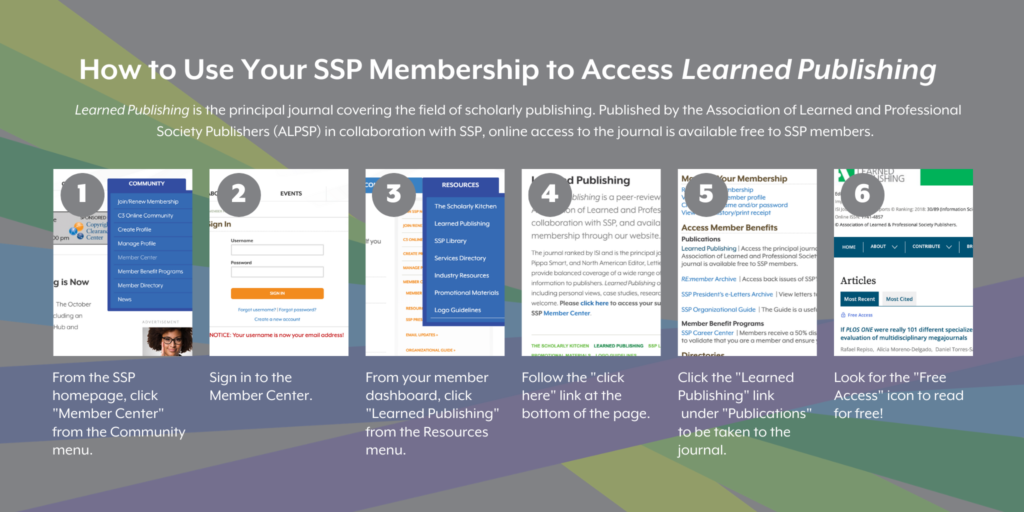Learned Publishing: Volume 36, No. 1, Jan. 2023
The first 2023 issue of Learned Publishing is dedicated to what achieves measurable improvements to our industry’s diversity, equity, inclusion, and accessibility (DEIA). As introduced in The Scholarly Kitchen, this issue is rich with case studies and lessons learned about what works in driving lasting change in scholarly communications.
For those interested in driving changes in editorial policy and operations:
• Chung, Yoon, and Kim outline Characteristics of Scholarly Journals Published in Non-English-Speaking Countries developed via their analysis of library and information science (LIS) journals (SCOPUS); among many key points, this study demonstrates the value of the diamond OA journal model for enabling greater international access to and inclusion in scholarly publishing.
• Bechelet and Rousseau-Portalis tell the story of a Chilean medical journal that understood a two-year effort to establish bilingual publishing workflows for articles submitted in Spanish, from peer review and copyediting to publication and dissemination – without impacting the financial stability of the journal.
• Huang, et al, present a cross-tabulation of articles published in the Island Studies Journal (ISJ) to evaluate the Tensions and Challenges in the Decolonisation of Academic Publishing. This article is an excellent demonstration of the routine diligence and mindfulness required of editors and publishers in order to break exclusionary cycles and avoid discriminatory scholarly publishing norms.
• Ricchi, et al, and Rosenberg, et al., offer examples of how language is a powerful tool in leveling the scholarly communications playing field and increasing accessibility to our industry as well as the publications we disseminate.
• Schrager, et al, and Watts, et al, address racism in medical and health services publishing respectively. These case studies spotlight how greater equity can be achieved in editorial teams, boards, authors, and staff; new mentorship programs for underrepresented authors were launched; and how these organizations are planning for continued advocacy efforts.
• Sarker and Burton-Jones, of MIS Quarterly, provide another first-hand case study of journal leadership simultaneously driving improvements in publishing practices as well as across the wider culture of a given discipline.
For those who work with metrics and want to understand the role of data in DEIA:
• Osborne-Martin, et al., demonstrate the data gap in our industry regarding the ratio of people with disabilities in both publishing staff and among our authors, editors, and reviewers. This paper points the way toward closing this gap by building disability data into our frameworks for achieving accessibility standards as well as greater inclusion in scholarly publishing as a whole.
• Spears, et al., present an Investigation of Potential Gender Bias in the Peer Review System at Reproduction, which uses systematic analysis of the possible role of gender in the review and publication of articles in one health science journal. This study concludes by presenting an evaluation model that could help publishers evaluate gender equity in their own journal programs.
• Wright discusses lessons learned by ProQuest’s efforts to establish standardized metadata that could facilitate more inclusive approaches to author and editor identities, whether related to race,
religions, gender, or other attributes.
For those leading DEIA committees, joint initiatives, and industry collaboration:
• Cooper, et al, present several measurable wins – from adopting accessible-image workflows to stablishing a board of early-career society members – generated by publisher-society partnerships. This paper concludes with recommendations for how to track the outcomes and benefits of revised publishing practices that move the DEIA needle.
• Kirk, Harris, and Chauhan focus on the gender and regional imbalances inherent in our systems of scholarly publishing awards and other professional recognition programs – and offer practical recommendations for building greater equity in our sector via the assembly of more diverse committees with operational transparency and wider promotional efforts.
• Lund, et al., present a systematic evaluation of four DEIA toolkits designed to drive improvements for scholarly communications providers and offer recommendations for deploying and improving upon these frameworks.
• McLeod, Snow, and Dormer trace the path taken by the Society for scholarly Publishing (SSP) as they navigated industry-wide DEIA initiatives From Working Group to Standing Committee. Encouraging those in power to disrupt their comfortable seat of privilege continues to be one of the biggest challenges and can be addressed via codes of conduct and other practical tools for implementing equitable and inclusive publishing practices.
• Meadows, et al, summarize how five scholarly information content and service providers implemented and measured the benefits of their DEIA strategies, comparing the experiences of large and small organizations with various motivations and constituencies.
• Smith presents a case study of De Gruyter’s new policy for authors requesting post-publication changes to their names, which followed recommendations by the Committee on Publication Ethics (COPE) and aligns with their pledge to the joint commitment for DEIA action.
• Swaminathan, Gedamu, and Sherer, report on their experiences establishing Springer Nature’s global DEI program. They offer lessons learned from the operational to the strategic, including their evolving metrics of success.
 Lettie Y. Conrad
Lettie Y. Conrad
North American Editor
Learned Publishing
NOTE: The first issue of the year is free to read (until end of 2023). All other issues of Learned Publishing from the last 2 years are free to read for all SSP or ALPSP members, both individual and organizational. Issues older than 2 years are fully open to all.
SSP members – please log in to the member center on the SSP website to access the full content.
To avoid missing any future issues, please be sure to receive an email alert or RSS feed every time a new issue goes online.




Join the Conversation
You must be logged in to post a comment.